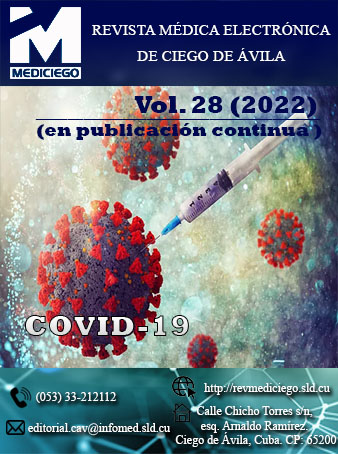Anesthetic care of Steiner's disease. case report
Keywords:
anesthesia, child, endotracheal, myotonic dystrophy, muscular dystrophiesAbstract
Introduction: myotonic dystrophy type 1 or Steinert's disease (OMIM 160900, ORPHA 273, ICD-9-MC359.21, ICD-10 G71.1, ICD-11 8C71.0) is the most prevalent myopathy in adults, although there are two forms of pediatric presentation: congenital myotonic dystrophy and the infantile onset variant. It constitutes a challenge for the anesthesiologist due to the complications that may arise during the surgical act.
Objective: to describe the anesthetic action in a patient with Steiner's myotonic disease.
Case presentation: 11-year-old white male patient weighing 58 kg, who was announced for laparoscopic exploration for undescended right testis. With a history of delayed dystocic delivery and cyanosis at birth, which required artificial ventilation in neonatology for a period of three days, with delayed psychomotor development diagnosed during the infant period, Steiner's myotonic disease. The anesthetic technique used, the drugs and control procedures in the preoperative period, during the surgical act and in the recovery period are described.
Conclusions: Steiner's disease is a challenge for the anesthesiologist due to the multisystemic effects that can lead to perioperative complications and even death during the surgical procedure or anesthetic recovery. Therapeutic conduct must be individualized and assessed during the perioperative period, a thorough anesthetic planning is recommended, anticipating complicationsDownloads
References
Gutiérrez-Gutiérrez G, Díaz-Manera J, Almendrote M, Azriel S, Barcena JE, Cabezudo-García P, et al. Guía clínica para el diagnóstico y seguimiento de la distrofia miotónica tipo 1, DM1 o enfermedad de Steinert. Med Clin (Barc) [Internet]. 2018 [citado 23 Ene 2020];153(2):[aprox 22 p.]. Disponible en: https://www.researchgate.net/profile/Gerardo-Gutierrez-Gutierrez-2/publication/332466662_Guia_clinica_para_el_diagnostico_y_seguimiento_de_la_distrofia_miotonica_tipo_1_DM1_o_enfermedad_de_Steinert/links/5d1cf1c0299bf1547c955354/Guia-clinica-para-el-diagnostico-y-seguimiento-de-la-distrofia-miotonica-tipo-1-DM1-o-enfermedad-de-Steinert.pdf
Fernández-Torrón R, Maneiro-Vicente M, Martí-Carrera I, La fuente-Hidalgo M, Cobo-Esteban AM, Martorell-Sampol L, et al. Miotonías distróficas. En: Gutiérrez-Rivas E, editor. Manual de enfermedades neuromusculares. Maja-dahonda: Ergón; 2017. p. 417–27.
Campbell C, Levin S, Siu VM, Venance S, Jacob P. Congenital myoto-nic dystrophy: Canadian population-based surveillance study. J Pediatr 2013;163(1):120-5.
Darin N, Tulinius M. Neuromuscular disorders in childhood: A descriptive epi-demiological study from western Sweden. Neuromuscul Disord. 2000;10:1-9.
González-de Dios J, Martínez-Frías ML, Egues-Jimeno J, Gairi-Tahull JM, Gómez-Sabrido F, Morales-Fernández MC, et al. Estudio epidemiológico de la distrofiamiotónica congénita de Steinert: características dismórficas. An Esp Pediatr [Internet]. 1999 [citado 23 Ene 2020];51(4):389-96. Disponible en: https://www.aeped.es/sites/default/files/anales/51-4-12.pdf
Moxley RT, Ciafaloni E, Guntrum D. Myotonic dystrophy. En: Darras BT, Jones R, Ryan MM, de Vivo DC, editores. Neuromuscular disorders of infancy, childhood,and adolescence: A clinician’s approach. London: Elsevier; 2015. p. 697–718.
Suáreza B, Araya G. Síndrome hipotónico como manifestación de enfermedad neuromuscular hereditaria en la infancia. Rev. med. clin. Condes [Internet]. 2018 [citado 23 Ene 2020];29(5):502-511. https://www.capacitacionesonline.com/blog/wp-content/uploads/2018/10/S%C3%ADndrome-hipot%C3%B3nico-como-manifestaci%C3%B3n-de-enfermedad-neuromuscular-hereditaria-en-la-infancia.-REV.-MED.-CLIN.-CONDES-2018.pdf
Mutchnick IS, Thatikunta MA, Gump WC, Stewart DL, Moriarty TM. Congeni-tal myotonic dystrophy: Ventriculomegaly and shunt considerations for thepediatric neurosurgeon. Childs Nerv Syst [Internet]. 2016 [citado 23 Ene 2020];32:609–16. Disponible en: https://link.springer.com/content/pdf/10.1007/s00381-015-2993-y.pdf
Rosado-Bartolomé A, Gutiérrez-Gutiérrez G. La distrofia miotónica de Steinerten urgencias. Emergencias [Internet]. 2016 [citado 23 Ene 2020];28(4):270–2. Disponible en: http://emergencias.portalsemes.org/descargar/la-distrofia-miotnica-de-steinert-en-urgencias/force_download/
Seijas-Gómez R, Basterra-Jiménez I, Luna-Lario P, Tirapu-Ustarroz J, Cabada-Giadas T, Iridoy-Zulet M, et al. Estudio descriptivo del perfil neuropsicológicoy psicopatológico en pacientes con distrofia miotónica tipo 1. Rev Neurol [Internet].2015 [citado 23 Ene 2020];61(12):529-35. Disponible en: https://academica-e.unavarra.es/bitstream/handle/2454/28451/distrofia.pdf?sequence=1&isAllowed=y
Molero-Díez YB, Sánchez-Hernando VJ, Ruiz-Simón FA. Aclaración en el manejo anestésico en la enfermedad de Steinert. Rev Mex Anestesiol [Internet]. 2021 [citado 23 Ene 2020]; 44(4):31. Disponible en: https://www.scielo.org.mx/pdf/rma/v44n4/0484-7903-rma-44-04-315.pdf
Molero-Díez YB, Sánchez-Hernando VJ, Ruiz-Simón FA, Gómez-Fernández M, Mateos-Arribas MT, García-Lázaro F. Manejo anestésico en la enfermedad de Steinert. A propósito de un caso. Rev. mex. Anestesiol [Internet]. 2021 [citado 23 Ene 2020];44(1):66-69. Disponible en: https://www.scielo.org.mx/pdf/rma/v44n1/0484-7903-rma-44-01-66.pdf
Oriol-López SA, Hernández-Bernal CE. Anestesia en la distrofia muscular de Steinert. Rev Mex Anest [Internet]. 2010 [citado 23 Ene 2020];33(3):160-5. Disponible en: https://anestesiar.org/WP/uploads/2012/04/cma103g.pdf
Vilaplana BJ, Villalonga MA. Capítulo 46. Aspectos clínicos del uso de bloqueadores neuromusculares en enfermedades neuromusculares. En: Álvarez-Gómez JA, González-Miranda F, Bustamante-Bozza R. Relajantes Musculares en Anestesia y Terapia intensiva, 2ª. Ed. Madrid: Arán, 2000. p.599-612.
Published
How to Cite
Issue
Section
License
Copyright (c) 2022 Alejandro Valdés Torres

This work is licensed under a Creative Commons Attribution-NonCommercial 4.0 International License.
Those authors who have publications with this journal accept the following terms of the License CC Attribution-NonCommercial 4.0 International (CC BY-NC 4.0):
You are free to:
- Share — copy and redistribute the material in any medium or format for any purpose, even commercially.
- Adapt — remix, transform, and build upon the material for any purpose, even commercially.
The licensor cannot revoke these freedoms as long as you follow the license terms.
Under the following terms:
- Attribution — You must give appropriate credit , provide a link to the license, and indicate if changes were made . You may do so in any reasonable manner, but not in any way that suggests the licensor endorses you or your use
- No additional restrictions — You may not apply legal terms or technological measures that legally restrict others from doing anything the license permits.
The journal is not responsible for the opinions and concepts expressed in the works, which are the exclusive responsibility of the authors. The Editor, with the assistance of the Editorial Committee, reserves the right to suggest or request advisable or necessary modifications. Original scientific works are accepted for publication, as are the results of research of interest that have not been published or sent to another journal for the same purpose.
The mention of trademarks of specific equipment, instruments or materials is for identification purposes, and there is no promotional commitment in relation to them, neither by the authors nor by the editor.






















